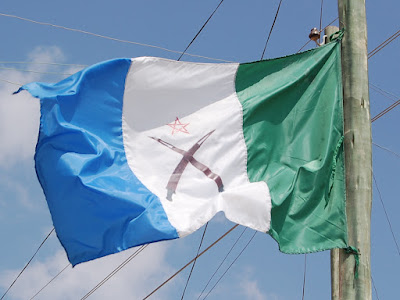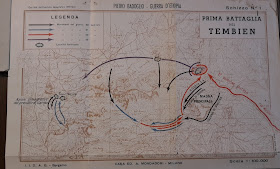
 In vendita qualche metro di corda, fatta a mano, per pochi Birr, cioè per 50 cents di euro.
In vendita qualche metro di corda, fatta a mano, per pochi Birr, cioè per 50 cents di euro.Some meters of hand-made rope for sale, for a few Birr ( 0,50 euro cents)
Le donne Afar portano anelli e braccialetti solo nella mano e nel braccio sinistro.
Les femmes Afar ne portent anneaux et bracelets que sur la main et le bras gauches.
The Afar women wear rings and bracelets only on their left hands and arms.
Les femmes Afar ne portent anneaux et bracelets que sur la main et le bras gauches.
The Afar women wear rings and bracelets only on their left hands and arms.

 Ragazza Afar. Une fille Afar. Afar girl.
Ragazza Afar. Une fille Afar. Afar girl. Un pastore Afar conduce i suoi dromedari per venderli al mercato.
Un pastore Afar conduce i suoi dromedari per venderli al mercato.Un berger Afar conduit ses dromadaires pour les vendre au marché.
An Afar shepherd brings the own dromadary to the market.
C'é una grande moschea a Ab-Ala uno dei più importanti centri abitati che si incontrano verso i territori ad est di Macallé. Nel villaggio convivono in apparente tranquillità Afar e Tigrigni, islamici e cristiani. In questo periodo a Macallé si sta benissimo, un tiepido sole ci tiene compagnia durante il giorno mentre la notte la temperatura scende e si dorme benissimo con la coperta; al contrario a Ab-Ala durante il giorno il sole picchia, siamo molto più bassi come quota e ci si avvicina alla depressione dancala. Il giovedì si svolge un importante mercato dove arrivano Afar anche da lontano per vendere i loro prodotti. Le donne si occupano della vendita del burro, sia per i capelli che per uso alimentare, corde vegetali, stuoie. Gli uomini Afar invece, mettono in vendita il loro bestiame: dromedari, capre e pecore. Mi volevano vendere un enorme dromedario dal pelo lucente e liscio, bella bestia davvero, a quattromila birr. Ho spiegato loro che tra poco sarei ritornato in Italia in "aeroplano" (anche in lingua amarica/tigrigna) e che la bestia é troppo grande per entrarci; questa spiegazione é stata sufficiente per smettere nelle loro insistenze.
Pare che sia vietato agli Afar di frequentare il mercato armati di kalashnikof e ghilé (jilé) e ai Tigrigni senza armi da fuoco i loro bastoni. Infatti il primo giovedì, giorno di mercato, erano tutti "disarmati". Al contrario durante la mia seconda visita erano tutti armati fino ai denti: pistole, mitra, ghilè di tutte le dimensioni (pugnali ricurvi), bastoni, poiché mancava il controllo della Polizia.
Avevo scattato molte foto nella mia precedente visita a donne Afar con le loro collane multicolori. Alcune le ho fatte stampare e alla mia seconda visita ho donato loro le foto. Hanno avuto un successone: desideravano tutte essere fotografate.
Nel mercato erano in vendita coperte nere di grandi dimensioni tessute con lana di pecora. Servono alle donne Afar per fare un "bagno di fumo". Hanno cercato di spiegarmelo ma sinceramente ho capito poco. Pare che accendono, dentro le loro tipiche capanne, un fuoco con un tipo di legna che produce tanto fumo. Ma non soffocano? E i loro occhi come fanno a resistere al fumo? Mi hanno promesso di farmi vedere a Macallé come funziona il "bagno di fumo" che serve per rendere liscia la pelle, tanto in voga tra le donne Afar e presso le donne tigrigne che possono permetterselo in città...
Pare che sia vietato agli Afar di frequentare il mercato armati di kalashnikof e ghilé (jilé) e ai Tigrigni senza armi da fuoco i loro bastoni. Infatti il primo giovedì, giorno di mercato, erano tutti "disarmati". Al contrario durante la mia seconda visita erano tutti armati fino ai denti: pistole, mitra, ghilè di tutte le dimensioni (pugnali ricurvi), bastoni, poiché mancava il controllo della Polizia.
Avevo scattato molte foto nella mia precedente visita a donne Afar con le loro collane multicolori. Alcune le ho fatte stampare e alla mia seconda visita ho donato loro le foto. Hanno avuto un successone: desideravano tutte essere fotografate.
Nel mercato erano in vendita coperte nere di grandi dimensioni tessute con lana di pecora. Servono alle donne Afar per fare un "bagno di fumo". Hanno cercato di spiegarmelo ma sinceramente ho capito poco. Pare che accendono, dentro le loro tipiche capanne, un fuoco con un tipo di legna che produce tanto fumo. Ma non soffocano? E i loro occhi come fanno a resistere al fumo? Mi hanno promesso di farmi vedere a Macallé come funziona il "bagno di fumo" che serve per rendere liscia la pelle, tanto in voga tra le donne Afar e presso le donne tigrigne che possono permetterselo in città...
***************
There is a big mosque in Ab-ala, one of the most important towns toward the territories East of Macallé. In the village, in apparent tranquility, live Afars and Tigrins, Islamics and Christians. During this period in Macallé it is very nice and warm sun keeps us company during the days while during the night the temperature goes down and sleeping with a blanket is perfect: contrary to Ab-Ala, during the day the sun is hot, we are not quite so high but close to the Dancalia Depression. On Thursdays there is an important market where the AFar unite from far away to sell their products. The women sell butter for their hair and as produce, ropes made from plants and mats. The Afar men sell their animals: dromedaries, goats and sheep. They wanted to sell me an enormous dromedary with a shiny and straight coat for 4000 Birr. I explained that in while I would be returning to Italy in an "airplane" (in Amharic/Tigrigna language) and that the animal was too big to board; this explanation was enough to have them quit insisting.
It seems that is forbidden for the Afars to come to the market armed with Kalashnikov and ghilé and for the tigrinians without fire arms and their sticks. In fact, on Thursdays, market-day, they were all "un-armed". But, in the contrary, during my second visit, they were armed to the hilt: pistols, machine-guns, swords and knives of all shapes and sizes, and sticks since there was no plice control.
I had taken several photographs during my previous visit of Afar women with the multicolored necklaces. Some of these I printed and during my second visit I gave them their photographs. It was quite a success: all of them wanted to be photographed.
In the market there were big blacks blankets for sale weaved with sheep yarn. It is used by the women to create a "smoke bath". They tried to explain this, but frankly I did not quite understand. It seems that they light, in their typical huts, a fire with a kind of log that produces a lot of smoke. But, don't they suffocate? And how can their eyes resist? They promised to show me in Macallé how the "smoke bath" works and how it helps keeps the skin smooth and soft-in vogue with the Afar and Tigrinians women.
It seems that is forbidden for the Afars to come to the market armed with Kalashnikov and ghilé and for the tigrinians without fire arms and their sticks. In fact, on Thursdays, market-day, they were all "un-armed". But, in the contrary, during my second visit, they were armed to the hilt: pistols, machine-guns, swords and knives of all shapes and sizes, and sticks since there was no plice control.
I had taken several photographs during my previous visit of Afar women with the multicolored necklaces. Some of these I printed and during my second visit I gave them their photographs. It was quite a success: all of them wanted to be photographed.
In the market there were big blacks blankets for sale weaved with sheep yarn. It is used by the women to create a "smoke bath". They tried to explain this, but frankly I did not quite understand. It seems that they light, in their typical huts, a fire with a kind of log that produces a lot of smoke. But, don't they suffocate? And how can their eyes resist? They promised to show me in Macallé how the "smoke bath" works and how it helps keeps the skin smooth and soft-in vogue with the Afar and Tigrinians women.



























